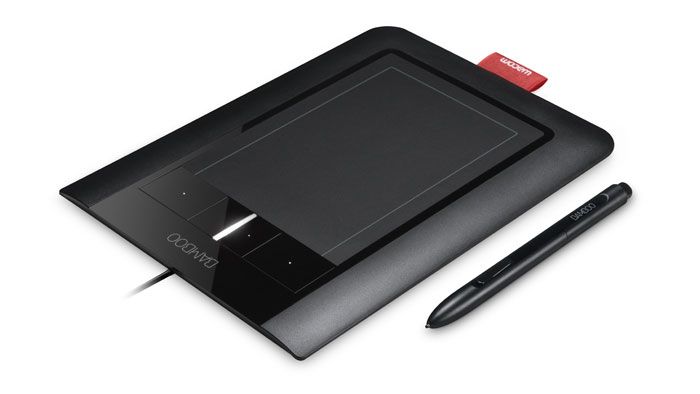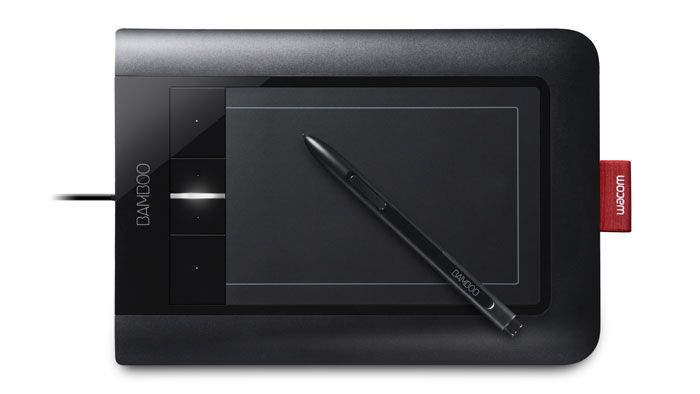With the Apple busy educating us about touch interfaces, the possibility of a large A5 sized touchpad to accompany your desktop or laptop seems appealing, after all if your phone can multi-touch why not your computer? Can the Wacom Bamboo Pen and Touch really offer you a more tactile experience over your mouse? We got touchy feely to find out.
Our quick take
On our first attempt at using the Bamboo Pen and Touch we found ourselves giving up. It's tough going at first, not helped by the sensitivity of the single finger click that will result in you randomly dragging folders across the screen, removing icons from your dock and deleting bookmarks in your browser (all happened). However once we turned off the single tap feature all these problems went away.
That's not to say that it doesn't then present a host of other problems, mainly that the single click "physical" button is then too small: we would have liked a massive "space bar" approach at the bottom of the tablet instead for example.
This is a gadget you'll have to persevere with to get the rewards. The mouse is so surprisingly agile and easy to use (after all that's probably all you've ever used to interact with a computer) that getting to grips with just using your fingers might be a little difficult.
That's not the fault of the hardware or the technology, it keeps up its side of the deal. The question here is whether you are able to adapt to get the most out of it.

Wacom Bamboo Pen and Touch - 4.0 / 5
| FOR | AGAINST |
|---|---|
|
|
The Bamboo Pen and Touch actually comes in five different guises: the Wacom Bamboo Pen and Touch CTH460; the Wacom Bamboo Touch CTT460; the Wacom Bamboo Pen CTL460; the Wacom Bamboo Craft CTH461; and finally the Wacom Bamboo Fun Pen & Touch CTH661.
Confused? You should be. In an attempt to appeal to all areas there are different versions that do different things. What you get, how it performs, and the price you pay varies on the package you choose with the Pen and Touch versions coming with both the ability to use your fingers and an included pen. The Touch version just offers you finger support, and as you might expect the Pen version says no to the hand. For the sake of this review we're looking at the Wacom Bamboo Pen and Touch.
Out of the box and the rather large touchpad (around A5 in size) sits on your desk in front on your computer or to the side. Connecting via a spare USB port there is no AC power or batteries required and it's slimline, black (or silver depending on model) and stylish.
The touch area takes up most of the real estate, but there is space for four large physical buttons down the side, for menus and clicking options. To give it that designer look there is a rather offensive red label sticking out the side, but once you realise this is to store the pen when not in use it's not too bad.
To use the tablet you'll have to install Wacom's accompanying software. The software supports both Mac and PC operating systems. We tested it on the Mac and found that the software wasn't evasive at all. During out testing we were able to have a Logitech mouse plugged in at the same time without confusion and after testing noticed no crazy behaviour once the tablet had been removed.
Although the package comes with a bundle of free software in the box (Adobe Photoshop Elements 7.0 Win/6.0 Mac and Nik Color Efex Pro 3.0 WE3) it's all optional and if you're happy using the photo package you've already got then so be it. That installation CD is important though as it not only includes the relevant drivers to make the tablet work, but also a very handy tutorial on how to use your new fangled toy. Instructions you soon find you'll need.
While you'll only need to watch the interactive video once to get to grips with the system you will need to watch it, as frustratingly the actions aren't tied into Apple's own multi-touch gestures. You can pinch, you can rotate, you can scroll, but you can't do three-finger swiping for example.
Once you've got your software installed and you've run through the tutorial you are on your own. The touch interface is reactive and we had no trouble mimicking the movements on the pad on screen. The tablet can be set-up for left- or right-handed users, the touch speed altered and fine tuned and the touch functions controlled. Don't like the ability to tap with one finger to replicate a click? No problem. Don't want touch on the tablet at all - you can do that too.
What application you are using determines what control features you get, but it's fair to say most programs support most features. Jump into Safari on the Mac and the tablet allows you to scroll vertically and horizontally or zoom in by simply pinching with your index finger and thumb. A single tap (it can be turned off) acts as a left-button click on a traditional mouse while a tap with two fingers acts as a right-button click.
Most programs we tested gave you some form of gesture control with Adobe Photoshop or iPhoto allowing you to rotate images, zoom and generally have greater control over what was going on on the touch side of things while clearly coming into their own with the pen.
So what's it like in use? Well it's just like the trackpad on your MacBook and MacBook Pro only bigger. From a touch aspect the biggest drawback we found was the lack of ability to press down on the whole device to click just like you can with the latest MacBooks. If you disable the one click tap, which we would highly recommend, then you are forced to find a smallish button with your thumb every time. Frustrating.
Get past the touchy feely element and the pen works as you would expect it giving you the ability to draw easily. It's Wacom's strength and you can tell. There are nice features like pressure-sensitive controls for the pen tip that react to how hard you press on the surface of the tablet and the tablet has a slightly textured surface for a "pen-on-paper feel".
To recap
The hardware works as its supposed to, it's just you might not be ready to adapt your way of using a computer just yet

